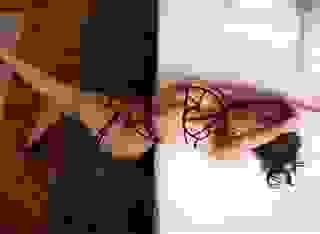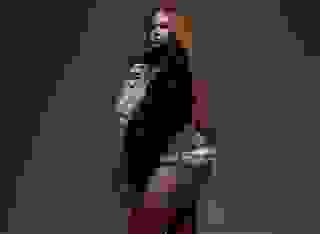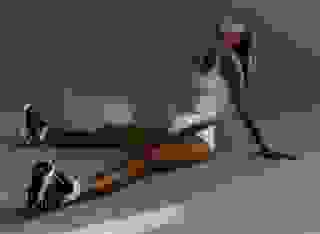Note: You can change font size, font face, and turn on dark mode by clicking the "A" icon tab in the Story Info Box.
You can temporarily switch back to a Classic Literotica® experience during our ongoing public Beta testing. Please consider leaving feedback on issues you experience or suggest improvements.
Click hereKusarigama: The Kusarigama was a composite weapon of feudal Japan. The Kusarigama consisted of a kama (the Japanese equivalent of a sickle) attached to a long metal chain (manriki) with a heavy iron weight (Fundo) or a Chakram (Shoge) at the end. Unlike the kama, the kusarigama's intended purpose as a weapon is obvious, so it could not be carried openly. It was 14 feet long, weighed 4 lbs, and consisted of Steel blade, as well as a Ball & Chain. The kusarigama was used to bludgeon opponents with the weighted end (Fundo), or entangle them with the chain, allowing the user to rush forward and finish the opponent off with the sickle end. The long length of the chain (10 feet or more) allowed the user to keep opponents at a distance, which made it useful when facing more heavily armored opponents, like a Samurai. The Koyketsu-Shoge is an identical weapon except that the scythe (Kama) is replaced with a bilhook (Koyketsu). The Shoge ring could be used instead of the Fundo weight. The Shoge was sharp and designed to cut from a distance. However this weapon was specifically used as a Grappling Hook for climbing trees and walls; both ends of the weapon can hook onto branches or roofs, and the Shoge ring can slide onto branches. Many fictionalized depictions of the kusarigama show the sickle end being swung around by the chain, although in all likelihood, the sickle would bounce off of its target without inflicting much, if any, damage.
Sagaris: The Sagaris was a weapon similar to a War Hammer or a small battle-axe. The Sagaris is either depicted with a blunt, hammer-like head or a sharp, ax-like head, with a long 'ice pick'-like point opposite it. The slender wooden handle was about 30 inches long. It was 30 inches long, weighed 2 lbs, and consisted of a wood shaft & iron head. The Sagaris was often used by cavalry units. It was light enough to be wielded one-handed, but could also pierce metal armor and helmets. A Sagaris wielded by Persian horseman Spithridates almost killed Alexander the Great at the Battle of Granicus.
Glaive: The Glaive was a bladed staff weapon. The Glaive consists of a long blade (typically up to 18 inches in length) on top of a wooden shaft about six or seven feet. The blade was fixed to the shaft by means of socket, much like an axe, rather than the tang of the similar Naginata. Often, the blade also had a hook opposite the of cutting edge. It was 8 feet long, weighed 5 lbs, and a 29 inch blade. The glaive was used both for slashing and stabbing, while the hook has used to pull riders from horseback. The glaive was demonstrated against a side of beef on a zip-line, simulating a charging horse, and easily pierced it.
Emei Piercers: The Emei Piercers, also called Emeici or Emei daggers, are a traditional Chinese martial art weapon, a Monk's secret weapon. Named after Mt. Emei, a Shaolin training ground, the Emei piercers are simply metal rods ending in arrowhead-shaped points. They are mounted on rings which allow the user to place them over his finger and spin them around as a form of distraction. More importantly, the ring mounting frees the hands for gripping opponents or other weapons, without having to drop the Emei. It was 1 feet long, weighed under 1 lb, and made of forged steel. The Emei piercers are stabbing weapons. Because of their short length, they can be concealed in one's sleeves until needed. It was tested on a gel torso. The expert landed four lethal blows on the gel torso's head in roughly as many seconds, demonstrating the Emei piercer's remarkable speed, accuracy and killing potential. However the weapon's very short range was noted as a problem.
Dao: The Dao is a traditional Chinese saber, also often called "broadswords" due to their wide blades, serving up perfectly severed body parts. "Dao" is a generic word for any single-edged blade, though it most commonly refers to a wide, slightly curved sword with a single cutting edge. The handle is wood wrapped in cloth to absorb sweat, with a circular or semicircular metal guard. Daos existed since the bronze age, but can be made out of iron or steel as well. The back side of the blade is designed to allow the second hand to push onto the blade; allowing more pressure and control in both the power and fluidity of the blade's slashes. It was 3 feet long, weighed 2.5 lbs, was single-edged, and was made of steel. The Jian and the Dao are the two most famous swords of ancient China. The dao have existed for centuries of Chinese history, although single-handed versions evolved during the Ming Dynasty. During World War II, shortages of firearms forced some Chinese soldiers to fight with the dao. This wasn't so unusual as Japanese Imperialist troops also used Katanas during the war. It is still practiced in modern wushu, where it is known as the "General of All Weapons". The dao can also be used as a thrusting weapon as well as a hacking weapon. The longsword variation of the Dao was called the 'Miaodao'. The Dao and Miaodao was used as late as WWII. Chinese militias and guerrilla fighters would primarily use their swords in ambushes against the Japanese. A propoganda song called 'The Sword March' was used to rally these swordsmen. It was not uncommon for Japanese to use their iconic Katanas to fight against the Chinese Dao, although the Japanese were more modernized than the Chinese during WWII and so would only launch Banzai Charges in either desperation or to shock attacks, similar to what the Chinese were also doing. When the People's Republic of China was founded, the use of the Dao was discontinued. Many Dao were intentionally destroyed by the anti-traditionalist Maoists. However the Dao is still used by Shaolin Monks today; although primarily for entertainment. The dao delivered five kill strikes against two pig carcasses in seven seconds. It perforated a pig carcass and it was theorized that it would hit the aorta and/or several vital organs that if the same thrust was to be performed on a person. The dao also cut two pig carcasses in half with two strikes each. The dao's thrusting speed was measured at roughly 4.9 mph.
Chariot Scythe: The Chariot Scythe was a slashing weapon. The Chariot Scythe was a two-foot long double-sided or quadruple-sided (meaning the blades formed a "plus" when viewed down the point) serrated blade on a short, round peg attached to the axles of the chariot. As the chariot moved forward, the scythes would spin with the wheel, allowing the charioteer to drive alongside an enemy, where the scythes would cut their legs out. The Persians used scythed chariots extensively following their experiences fighting the Greeks heavy infantry. According to the Persian/Celt episode, a chariot scythe can hit the wheels of an enemy's chariot, instantly paralyzing the chariot. When Alexander the Great was confronted by Persian chariots, he took advantage of these cumbersome units by having his troops create a U-shaped formation just before the chariots hit. Trapped by the bodies of the soldiers it killed, the chariots were then at the mercy of the surviving Macedonians' Sarissas. Pomponius Nela reported that the Romans invading Britain encountered Celts driving chariots armed with scythes. Pomponius claimed that it was these Celts that invented the chariot scythes: however, there is no historical evidence to support this claim and it was likely just political propaganda meant to make the Celts seem more advanced than they really were. There is no accepted archaeological evidence concerning Celtic scythed chariots. There are some large heavy scythe blades from late Roman Britain which are too unwieldy for a man to use. The Persians knew how vital the horse was as a weapon of war. All Immortals were trained to tame horses.
Chakram: The Chakram is a throwing disc used by several Indian warrior castes. The chakram is a hoop-shaped disk with the outer edge sharpened. Chakrams come in various sizes and are usually made of steel or brass. Some chakrams, even those used in combat, were ornately engraved, or inlaid with brass, silver, or gold. The chakram can be considered a distant cousin of the Shuriken. The chakram was used extensively by the Indian warrior castes such as the Rajput and Sikhs. Numerous chakrams of different sizes were worn around the arms, necks, and stacked onto turbans. The chakram was thrown several different ways: by being held between the thumb and forefinger and thrown underhand, or spun around the index finger and flung. The aerodynamic shape of the body prevented it from being deflected by the wind. The Chakram had a range of 50 feet. Chakrams could also be used as melee weapons; akin to Brass Knuckles but with more cutting force. The Japanese had a similar weapon known as the Kanawa (Golden Ring), which was occasionally used by the Ninja.
Cane Knife: The Cane Knife is a tool used for cutting sugarcane, a farming tool-turned-executioner's weapon. The cane knife is characterized by a hardwood handle, full tang, and a deep curved blade. Some models have a hook at the end that is used to pick at cut sugarcane. It weighed 1.25 lbs, had a ⅛ inch width blade, 13.5 inch steel blade, and a wood handle. The cane knife is used primarily for harvesting sugarcane, and is most commonly found in countries with a large sugarcane industry. Because of its effectiveness at cutting and wide availability, it is commonly used as an improvised weapon. Both of these uses make it similar to the machete. Many farming nations around the world have access to cane knives. However the other Shadows claimed that similar tools are used in Iraq for farming and although the Iraqi military could have used the cane knife, they didn't and preferred knives that were smaller thus more portable and flexible, and more lethal as those could stab. The Khmer Rouge used cane knives and improvised clubs as the second most common execution of the genocide, only the famine and people being forcefully worked to death created more casualties. They would aim the weapon at the back of the head or neck, and most of these corpses had their stomaches opened and necks slit even after the fact that they were already dead.
Ninjato: The Ninjato or Shinobikatana is a single-edged sword from feudal Japan; three feet of razor sharp steel, perfect for slashing and stabbing. It was 34 inches long, weighed 2 lbs, and made of tempered carbon steel. The ninjato is typically depicted as being a short sword, (similar to that of a Shikomizue or Joto). This was to trick opponents into thinking his enemy had a full length Katana and overestimate how long it would take to draw the sword, since it does not take as long to unsheathe a ninjato and with the longer handle would not be at a disadvantage as far as length was concerned. There is evidence to suggest that the Ninjato was simply a sword commonly used by Ashigaru or common foot soldiers. It was actually more common for a Ninja to steal a sword from battlefields or to buy/sell them in black markets in order to get them. Many Ninjatos were simply modified Katanas. As there is no reliable historical account of the ninjato, most designs are based on speculation. It's design is often considered to be similar to the tantō (a variant of Japanese short swords/daggers). In many Hollywood films, the ninjato is a straight bladed sword with a square tsuba (hand guard). The Wakizashi is a very similar sword to the Ninjato; normally being used as a sidearm if a Samurai lost his primary weapon. Ninjas would use this sword in an identical manner to that of the Ninjato; as a lighter and faster weapon compared to the Katana. There are theories that the ninjato was fitted with a Nodachi sized handle and carried in a Katana-length scabbard. The ninjato was primarily a slashing sword, although it might have been used for thrusting and stabbing as well. The shorter sword blade coupled with the long scabbard allowed it to be drawn from the scabbard more quickly than the opponent could anticipate. The ninjato would have been more suited for indoor use than the Katana, because it required less swinging room. A straight bladed ninjato would be more suitable for stabbing and thrusting, making it the more logical weapon to use compared to a slashing weapon, while trying to assassinate a Samurai. As the Samurai used lamellar armor that was better at defending against slashing attacks than it was against thrusting attacks. Since the Samurai rarely fought against short swords it was easy for Ninjas to use the cover of night to trick the Samurai into believing that the Ninja was wielding a long Katana. Also, similar to a cutlass, the Ninjato's short size made it superior in indoor combat to the longer Katana. The Saya (scabbard) of the Ninjato was also used as a weapon. It could block enemy blows and also carry glass and dust used to blind the enemy (similar to the Black Egg). In the Iga-Ryu Ninja Museum in Iga Ueno, Japan their is a ninjato (or shinobi-gatana) is described as follows: "A straight sword with a distinct rectangular guard. The sheath of the shinobi-gatana has a triangular end. The ninja could climb a fence by driving the sword in the ground and stepping on the guard, leaving no evidence by retrieving it by its long sword knot. Although popular, from the closing days of the Tokugawa shogunate, the ninja's sword was more a symbol-like item rather than a practical one."
Naginata: The Naginata is a bladed staff weapon from medieval Japan, 7 feet of carving power tipped by a razor-sharp blade. The Naginata was seven feet in length, with a long sword-like blade and a circular guard on the end of a wooden shaft. While the Naginata was used in Japan, it was mainly used by monks (Sõhei) and other martial art practicing groups. It was not largely used by the Samurai themselves, but it is said that it was used by the wives of Samurai (Onna-bugeisha) to protect themselves and their homes while their husbands were away. In reality, a Samurai would more frequently use a long Spear called a Yari. While not as effective as the Naginata in terms of slashing power, it was more effective in thrusting. However the Onna-bugeisha and other garrison forces would prefer the Naginata since it was a more versatile weapon; allowing the defender to be more adaptive since it was impossible to prepare and specialize against ambushing raiders. The Sōhei, semi-independent militaristic warrior monks, also frequently used the Naginata in combat. The Onna-bugeisha, essentially female Samurai, used the naginata as their signature weapon. The naginata proved itself as a quick ranged weapon by slicing a dummy with several quick cuts, taking off part of the skull and exposing the brain in one, slashing through the face and jaw and slicing off part of the jawbone in the second, and breaking through the rib and stabbing the heart on the last. While the naginata showed good speed and versatility, it was noted that it lacked killing potential compared to heavier weapons like the viking longsword and did not get the edge over the viking's longsword. It failed to cut through a Spartans bronze breastplate.
Back at the dorm apartment building....
Naomi and Nora were both lying in bed together. Naomi smiled and began to stroke Nora's head. The young speedster was giving the young DEO agent a sloppy blowjob.
Nora loved sucking Naomi's cock. "Babe," Nora said. "Can you please read me a story while you fuck me vaginally missionary style?"
Naomi smiled and nodded. She pulled down Nora's pants and panties. She then rubbed the young speedster's snatch with her fingers. The young DEO agent then spat on her fingers and then rubbed them against Nora's cunt. "You know that I love you so much," Naomi said. She then proceeded to slip her fingers inside Nora, penetrating the young speedster's snatch.
"Can't you just fuck me baby?" Nora pleaded. "I want you to make me cum."
Naomi smiled. She kissed her girlfriend's lips and guided her cock towards the young speedster's snatch. Without any hesitation, she pushed forward and penetrated Nora's cunt. Both girls moaned in pleasure. The heat between their young bodies was intense and passionate. Naomi smiled and wrapped her arms and legs around Nora, pulling the young speedster closer to her own body. "Okay," Naomi said as she fucked Nora deep and slowly. "Which story would you like to hear?"
Nora smiled and rested her head against her girlfriend's shoulder. "The tale of the three little sluts," she said. "I love that story."
Naomi smiled. She pulled out her phone and opened the app called 'Adult Fairytales'. She cleared her throat and began to read the story. "This is the story of the Three Little Sluts. Once upon a time there was an old mother futa who had three little futas and not enough food to feed them. So when they were old enough, she called them to her."
"The mother futa had three cocks. Her daughters began to suck on each cock. 'My darling girls,' the mother said. 'Mommy is getting very old and tired. You must head out and seek your own fortunes. You're 18 years old.'. She sent them out into the world to seek their fortunes."
"Now these three girls were not very experienced in fortunes," Naomi read as she fucked Nora's snatch hard and deep with each thrust. "But, they needed money to pay for their sextoys, porn films, and adult magazines. The first little futa was very lazy. She didn't want to work at all, she just wanted to suck on her own cock. Each of them had a 14 inch long cock and 38CC breasts. The three girls were each 3 inches tall and weighed 40 lbs."
"The first girl sighed. She had caucasian skin, long blonde hair, and green eyes. She saw a bunch of straw and smiled. 'That's it,' she said. 'I'll make my house out of straw. But I need someone to help me with it.'. Suddenly a farmer walked over. The girl smiled. She asked the farmer to help her build a house of straw. In return, the farmer could fondle her body. The farmer agreed and the girl built her house out of straw."
"The second little girl worked a little bit harder but she was somewhat lazy too and she built her house out of sticks. She had caucasian skin, long brown hair, and blue eyes. Then, they sang and danced and played together the rest of the day. The two lazy girls would suck on their own dicks all day and night."
"The third little girl worked hard all day and built her house with bricks. She had caucasian skin, long red hair, and brown eyes. It was a sturdy house complete with a fine fireplace and chimney. It looked like it could withstand the strongest winds. She smiled as she cooked and cleaned all day. Once the work was done, she would then give herself a blowjob."
"The next day, an older futa happened to pass by the lane where the three little girls lived. She was 7 feet 5 inches tall and 210 lbs. She had an 89 inch long cock. Her lips were red as a rose, hair as white as snow, and skin as black as ebony. She wanted to have intercourse with an 18 year old girl. She saw the straw house, and she could smell the girl inside. The scent of the girl's sexual urges filed her nostrils. Her cock got harder. She thought the girl would make a mighty fine fuck and her mouth began to water as she fantasized about plowing the girl's every holes. The futa woman then decided to get a look at the young girl."
Suddenly Nora came hard, squirting her juices all over Naomi's cock. Naomi smiled and thrusted hard and came hard, spurting her futa spunk deep inside Nora's snatch.
"Let's head to the living room," Naomi said. "The others probably want to hear the rest of the story."
Nora nodded. Naomi smiled. She picked Nora up and carried her towards the living room. They then sat down on the couch and smiled. The other girls were there waiting for Naomi to continue the story. Naomi cleared her throat and continued to tell the story. The other girls either had oral, vaginal, or anal intercourse with each other as Naomi read the story.







